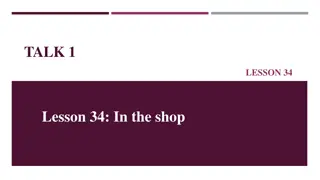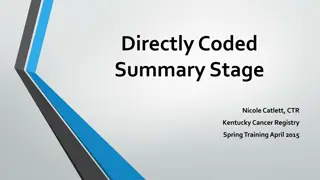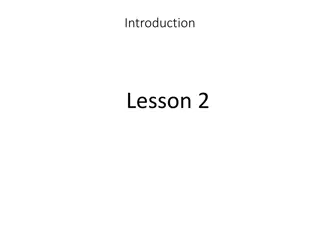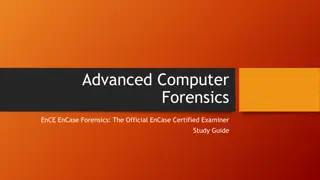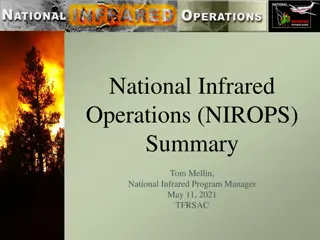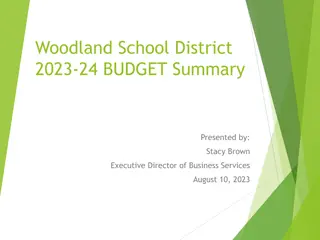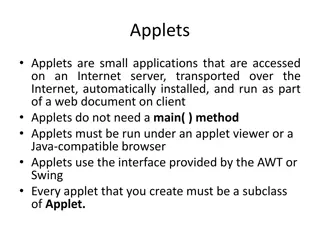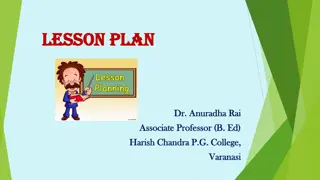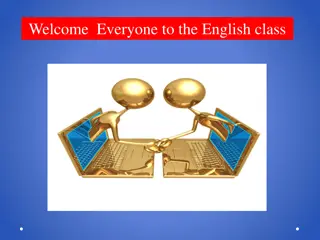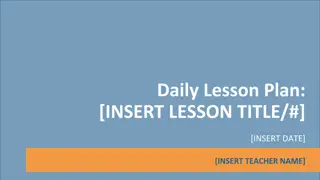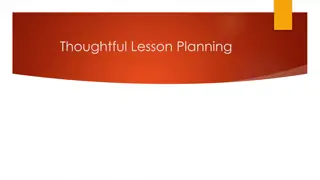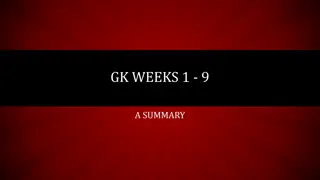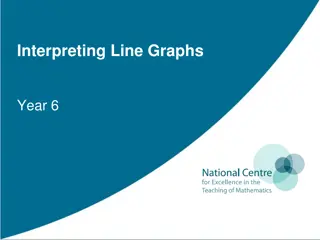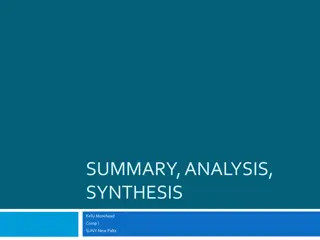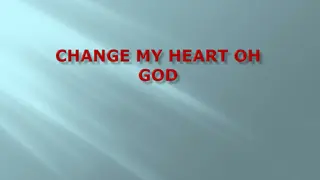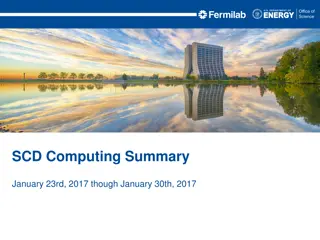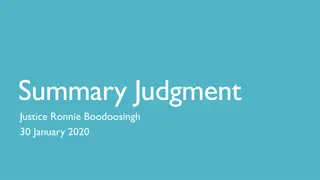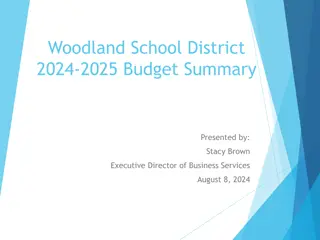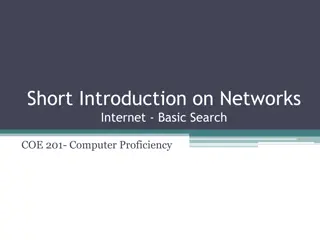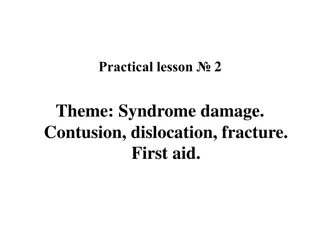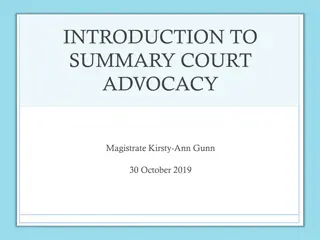C Introduction Lesson Overview and Basics Summary
This text provides an overview of a C programming lesson, covering topics such as the character set, case sensitivity, string literals, comments, standard input and output, and more. It includes code snippets and explanations to help beginners understand fundamental concepts of C programming.
Download Presentation

Please find below an Image/Link to download the presentation.
The content on the website is provided AS IS for your information and personal use only. It may not be sold, licensed, or shared on other websites without obtaining consent from the author. Download presentation by click this link. If you encounter any issues during the download, it is possible that the publisher has removed the file from their server.
E N D
Presentation Transcript
C Introduction Lesson Outline 1. C Introduction Lesson Outline 2. hello_world.c 3. C Character Set 4. C is Case Sensitive 5. Character String Literal Constant 6. String Literal Cannot Use Multiple Lines 7. Multi-line String Literal Example 8. Newline 9. Newline Example 10. White Space 11. Statements 12. Statement Terminator 13. Standard Input & Standard Output 14. Block Delimiters 15. What Is a Comment? #1 16. What Is a Comment? #2 17. Are Comments Necessary? 18. hello_world.c with Comments 19. hello_world.c without Comments 20. Flowchart for hello_world.c C Introduction Lesson CS1313 Fall 2024 1
hello_world.c /* ************************************************* *** Program: hello_world *** *** Author: Henry Neeman (hneeman@ou.edu) *** *** Course: CS 1313 010 Fall 2024 *** *** Lab: Sec 014 Fridays 1:00pm *** *** Description: Prints the sentence *** *** "Hello, world!" to standard output. *** ************************************************* */ #include <stdio.h> int main () { /* main */ /* ******************************** *** Execution Section (body) *** ******************************** * * Print the sentence to standard output * (i.e., to the terminal screen). */ printf("Hello, world!\n"); } /* main */ C Introduction Lesson CS1313 Fall 2024 2
C Character Set These are the characters that C recognizes (specifically, the characters that can be typed on a standard US English QWERTY computer keyboard): Letters (upper case and lower case) A B C D E F G H I J K L M N O P Q R S T U V W X Y Z a b c d e f g h i j k l m n o p q r s t u v w x y z Digits 0 1 2 3 4 5 6 7 8 9 Special Characters (punctuation etc) space (also known as blank) " ( ) * + - / : = ! & $ ; < > % ? , . # @ { } [ ] \ | C Introduction Lesson CS1313 Fall 2024 3
C is Case Sensitive C is case sensitive: it distinguishes between UPPER case (CAPITAL) and lower case (small) letters. Keywordsin C for example, the keyword int MUST be in lower case. For example: #include <stdio.h> int main () { /* main */ int height_in_cm; height_in_cm = 160; printf("My height is %d cm.\n", height_in_cm); } /* main */ C Introduction Lesson CS1313 Fall 2024 4
Character String Literal Constant A character string literal constant is a sequence of characters delimitedby a double quote at the beginning and a double quote at the end. A character string literal constant is also known as a character string literal or a string literal for short. For example, in thisprintf statement: printf("This is a printf.\n"); the following is a string literal: "This is a printf.\n" The output of this printf statement is: This is a printf. followed by a newline, also known as a carriage return. C Introduction Lesson CS1313 Fall 2024 5
String Literal Cannot Use Multiple Lines A character string literal constant can only use one line; that is, both of its delimiters (the double quotes) MUST be on the same line of source code text. So, each of these is CORRECT: printf("This string literal takes one line"); printf(" and so does this string literal.\n"); And this is WRONG WRONG WRONG: printf("This string literal takes more than one line so it's WRONG!\n"); Some compilers will accept this but won t be happy; other compilers will simply reject it. Regardless, if this appears in a program in CS1313, YOU WILL BE SEVERELY PENALIZED! C Introduction Lesson CS1313 Fall 2024 6
Multi-line String Literal Example % cat bad_string_literal.c #include <stdio.h> int main () { /* main */ printf("This string literal takes more than one line so it's WRONG!\n"); } /* main */ % gcc -o bad_string_literal bad_string_literal.c gcc bad_string_literal.c bad_string_literal.c: In function main : bad_string_literal.c:5: error: missing terminating " character bad_string_literal.c:6: error: more undeclared (first use in this function) bad_string_literal.c:6: error: (Each undeclared identifier is reported only once bad_string_literal.c:6: error: for each function it appears in.) bad_string_literal.c:6: error: expected ) before than bad_string_literal.c:6: error: missing terminating ' character bad_string_literal.c:7: error: expected ; before } token C Introduction Lesson CS1313 Fall 2024 7
Newline In C, you can place a newline, also known as a carriage return, inside a string literal using: \n If a newline appears inside a string literal in the source code, then when the string literal is output, the newline causes the output to move to a new line. C Introduction Lesson CS1313 Fall 2024 8
Newline Example % cat newline.c #include <stdio.h> int main () { /* main */ printf("Howdy do!\n"); printf("This string literal contains a newline in the\nmiddle "); printf("but this string literal contains a newline at the end.\n"); printf("So there!\n"); } /* main */ % gcc -o newline newline.c % newline Howdy do! This string literal contains a newline in the middle but this string literal contains a newline at the end. So there! Note: In general, it s better programming practice to put newlines only at the end of your string literals, not in the middle, because in the middle they can be difficult for programmers (for example, graders) to see. C Introduction Lesson CS1313 Fall 2024 9
White Space White space is the general term for all of: blank spaces; tabs; carriage returns. The term comes from the parts of standard typing paper that don t have any ink on them. C Introduction Lesson CS1313 Fall 2024 10
Statements A statement in a program is like a sentence in a natural language: it s the smallest possible collection of words and punctuation that can stand by itself and have meaning. For example: printf("Hello, world.\n"); This statement is known as a printf statement (pronounced print-eff ). It tells the compiler to output to the terminal screen the string literal Hello, world. followed by a newline. C Introduction Lesson CS1313 Fall 2024 11
Statement Terminator In C, every statement ends with a semicolon, which is known as the statement terminator. For example: int height_in_cm; height_in_cm = 160; printf("My height is %d cm.\n", height_in_cm); Notice: A statement CAN take more than one line (but recall that a string literal CAN T take more than one line). The way you find the end of a statement is by finding its statement terminator. The way you find the start of a statement is by finding the statement terminator of the previous statement. C Introduction Lesson CS1313 Fall 2024 12
Standard Input & Standard Output Standard input is a user typing at the keyboard. It is sometimes shortened to stdin, pronounced standard in. Standard output is the computer outputting to the terminal screen. It is sometimes shortened to stdout, pronounced standard out. In C: a scanf statement always inputs from stdin, and a printf statement always outputs to stdout. More on this later. C Introduction Lesson CS1313 Fall 2024 13
Block Delimiters The open curly brace, also known as the left brace, { acts as the start of a block and is known as the block open. The close curly brace, also known as the right brace, } acts as the end of a block and is known as the block close. The block open and block close are said to delimit the block: they indicate where the block begins and where the block ends. Delimit: Indicate where something begins and ends. C Introduction Lesson CS1313 Fall 2024 14
What Is a Comment? #1 A commentis a piece of text in a source file that: tells human beings (for example, programmers) something useful about the program, BUT is ignored by the compiler, so it has absolutely no affect on how the program runs. In C, the start of a comment is indicated by /* and the end of a comment is indicated by */ All text appearing between these comment delimitersis part of the comment, and therefore is ignored by the compiler. Delimit: Indicate where something begins and ends. C Introduction Lesson CS1313 Fall 2024 15
What Is a Comment? #2 A commentis a piece of text in a source file that: tells human beings (for example, programmers) something useful about the program, BUT is ignored by the compiler, so it has absolutely no affect on how the program runs. In C, the start of a comment is indicated by /* and the end of a comment is indicated by */ A comment can use multiple lines of text. The delimiters DON T have to be on the same line. C Introduction Lesson CS1313 Fall 2024 16
Are Comments Necessary? Comments are ignored by the compiler, so strictly speaking they aren t needed to compile and run. But, if you don t put them into one of your CS1313 programming projects, YOU MAY LOSE A FULL LETTER GRADE OR MORE on that project. Why? Comments tell human beings useful things about your program. They help programmers including you, a month later when you ve forgotten everything about your program to understand your program. They also tell gradersthat you know what the heck you re doing. C Introduction Lesson CS1313 Fall 2024 17
hello_world.c with Comments /* ************************************************* *** Program: hello_world *** *** Author: Henry Neeman (hneeman@ou.edu) *** *** Course: CS 1313 010 Fall 2024 *** *** Lab: Sec 014 Fridays 1:00pm *** *** Description: Prints the sentence *** *** "Hello, world!" to standard output. *** ************************************************* */ #include <stdio.h> int main () { /* main */ /* ******************************** *** Execution Section (body) *** ******************************** * * Print the sentence to standard output * (i.e., to the terminal screen). */ printf("Hello, world!\n"); } /* main */ C Introduction Lesson CS1313 Fall 2024 18
hello_world.c without Comments #include <stdio.h> int main () { printf("Hello, world!\n"); } C Introduction Lesson CS1313 Fall 2024 19
Flowchart for hello_world.c An oval denotes either the start or the end of the program, or a halt operation within the program (which we ll learn about later). int main () { printf("Hello, world!\n"); } Start A parallelogram denotes either an input operation or an output operation. Output Hello, world! End An arrow denotes the flow of the program. References: http://www.edrawsoft.com/flowchart-symbols.php C Introduction Lesson CS1313 Fall 2024 20



